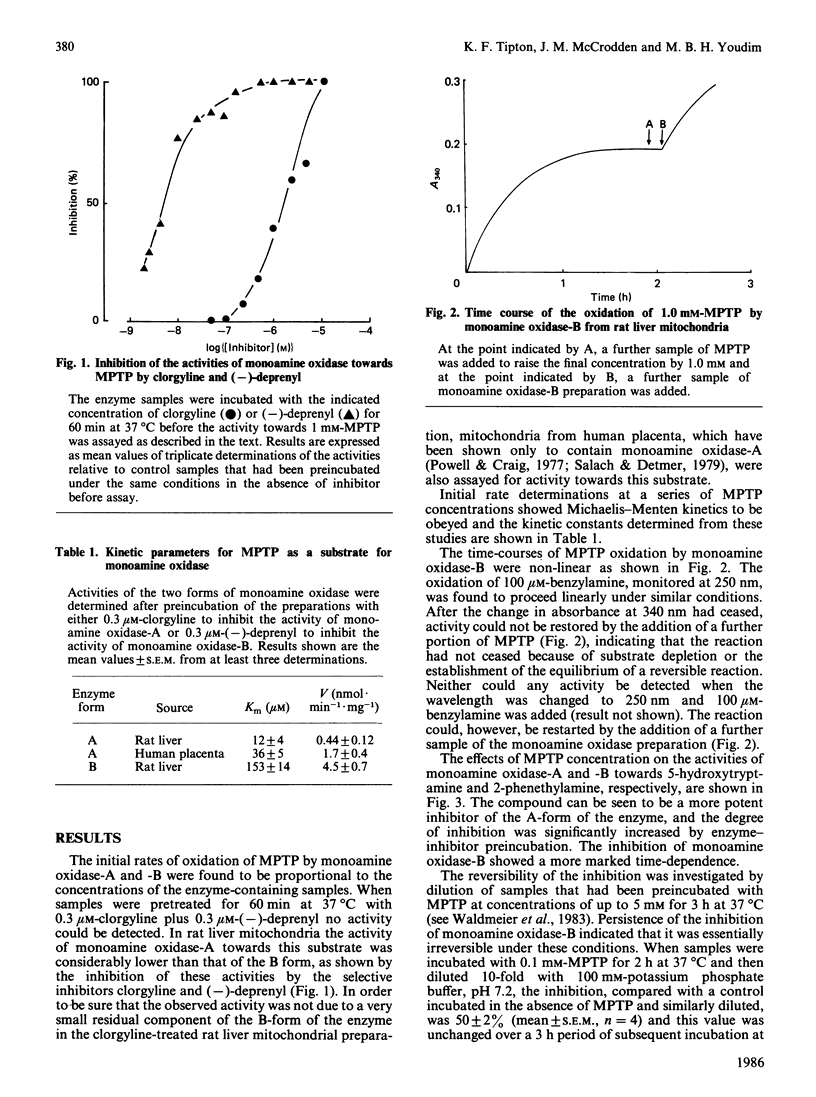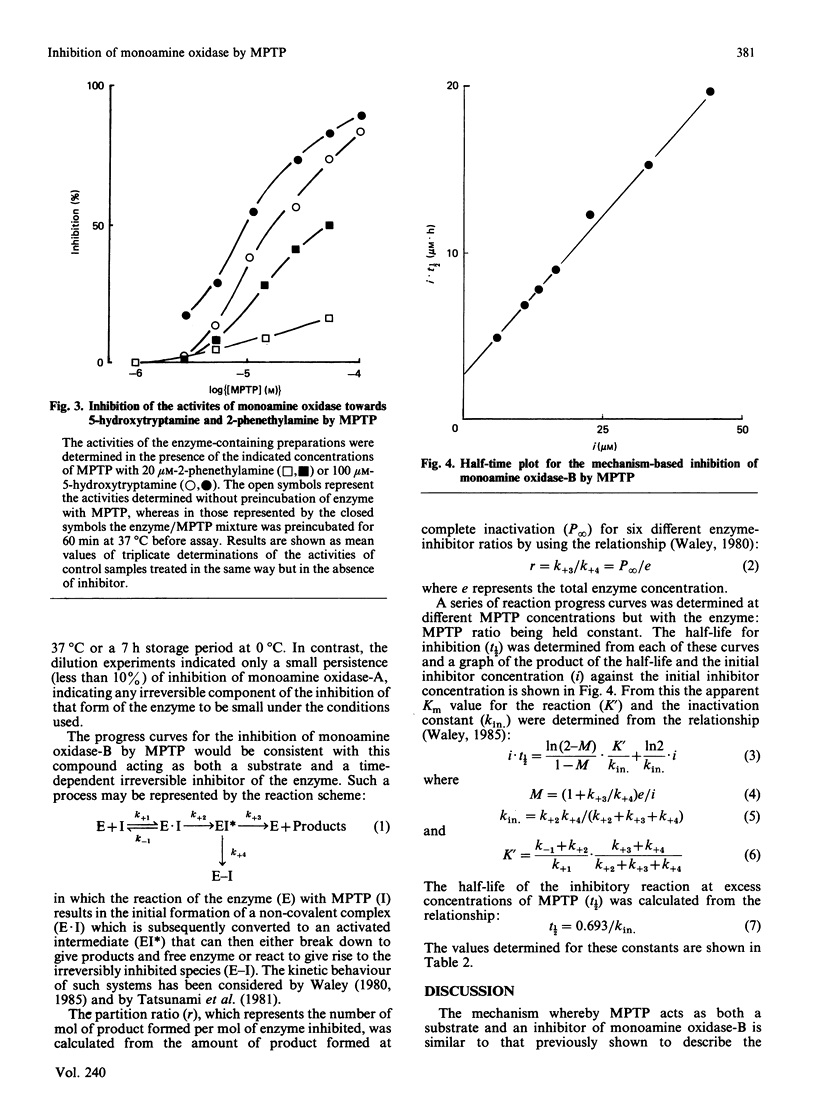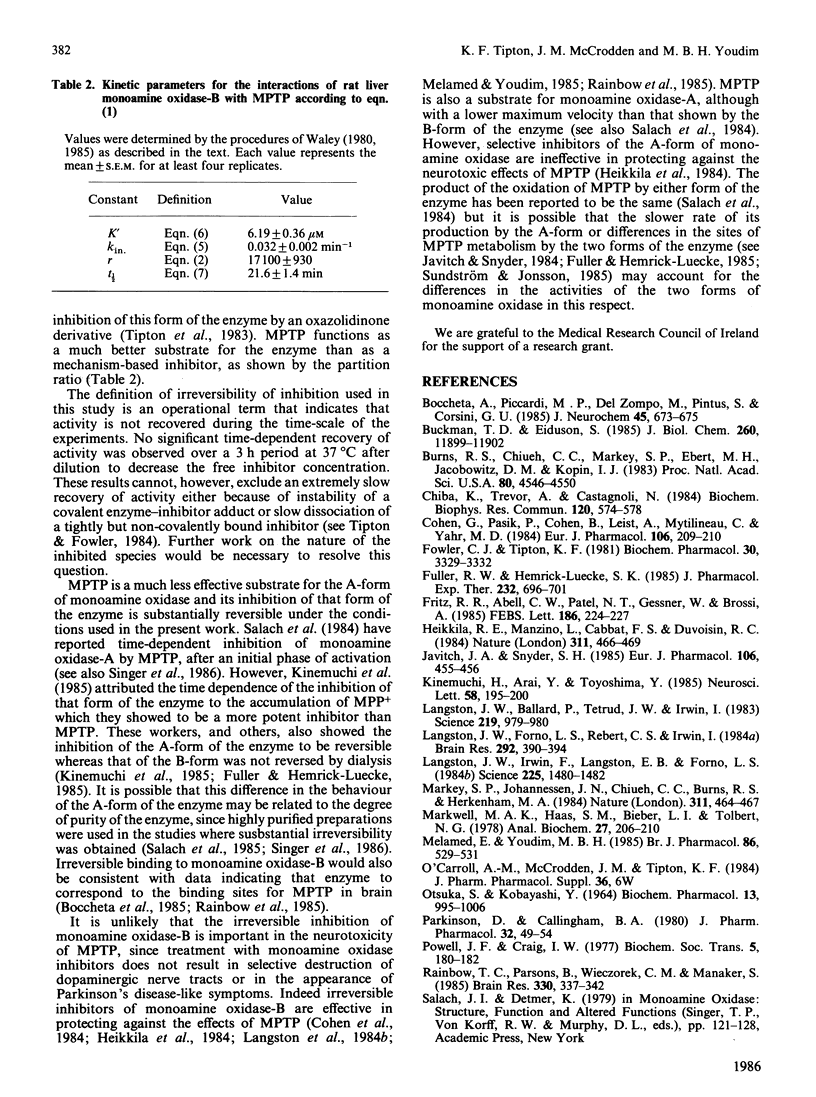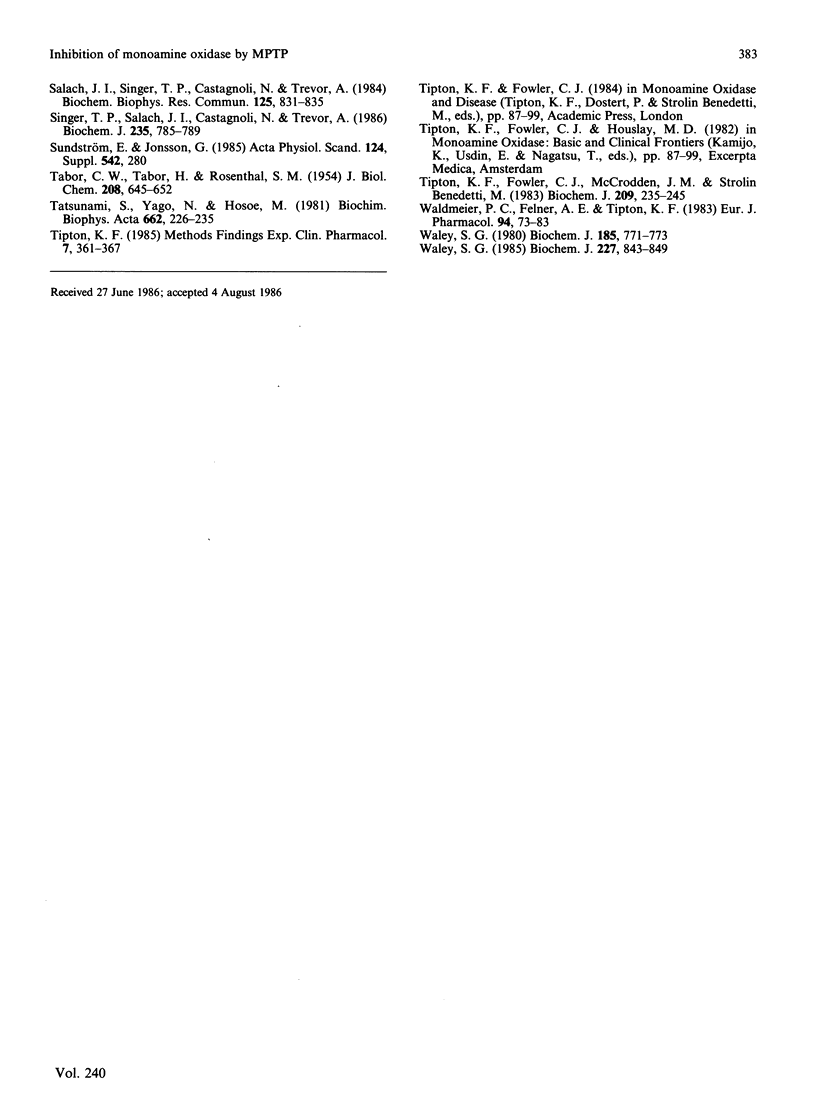Abstract
The compound 1-methyl-4-phenyl-1,2,3,6-tetrahydropyridine (MPTP), which produces symptoms resembling Parkinson's disease in humans, acts both as a substrate and an enzyme-activated irreversible inhibitor of the B-form of monoamine oxidase from rat liver. Analysis of the inhibitory process showed the compound to be considerably more efficient as a substrate than as an irreversible inhibitor, with about 17000 mol of product being formed per mol of enzyme inactivated. The half-time of the inhibitory process was about 22 min. With the A-form of the enzyme, the compound had a lower Km value and a considerably lower maximum velocity than the corresponding values obtained with the B-form. Under the conditions used in the present work the inhibition of the A-form of the enzyme was largely reversible.
Full text
PDF




Selected References
These references are in PubMed. This may not be the complete list of references from this article.
- Bocchetta A., Piccardi M. P., Del Zompo M., Pintus S., Corsini G. U. 1-Methyl-4-phenyl-1,2,3,6-tetrahydropyridine: correspondence of its binding sites to monoamine oxidase in rat brain, and inhibition of dopamine oxidative deamination in vivo and in vitro. J Neurochem. 1985 Sep;45(3):673–676. doi: 10.1111/j.1471-4159.1985.tb04045.x. [DOI] [PubMed] [Google Scholar]
- Buckman T. D., Eiduson S. Photoinactivation of B-type monoamine oxidase by a 1-methyl-4-phenyl-1,2,3,6-tetrahydropyridine metabolite. J Biol Chem. 1985 Oct 5;260(22):11899–11902. [PubMed] [Google Scholar]
- Burns R. S., Chiueh C. C., Markey S. P., Ebert M. H., Jacobowitz D. M., Kopin I. J. A primate model of parkinsonism: selective destruction of dopaminergic neurons in the pars compacta of the substantia nigra by N-methyl-4-phenyl-1,2,3,6-tetrahydropyridine. Proc Natl Acad Sci U S A. 1983 Jul;80(14):4546–4550. doi: 10.1073/pnas.80.14.4546. [DOI] [PMC free article] [PubMed] [Google Scholar]
- Chiba K., Trevor A., Castagnoli N., Jr Metabolism of the neurotoxic tertiary amine, MPTP, by brain monoamine oxidase. Biochem Biophys Res Commun. 1984 Apr 30;120(2):574–578. doi: 10.1016/0006-291x(84)91293-2. [DOI] [PubMed] [Google Scholar]
- Cohen G., Pasik P., Cohen B., Leist A., Mytilineou C., Yahr M. D. Pargyline and deprenyl prevent the neurotoxicity of 1-methyl-4-phenyl-1,2,3,6-tetrahydropyridine (MPTP) in monkeys. Eur J Pharmacol. 1984 Oct 30;106(1):209–210. doi: 10.1016/0014-2999(84)90700-3. [DOI] [PubMed] [Google Scholar]
- Fowler C. J., Tipton K. F. Concentration dependence of the oxidation of tyramine by the two forms of rat liver mitochondrial monoamine oxidase. Biochem Pharmacol. 1981 Dec 15;30(24):3329–3332. doi: 10.1016/0006-2952(81)90607-9. [DOI] [PubMed] [Google Scholar]
- Fritz R. R., Abell C. W., Patel N. T., Gessner W., Brossi A. Metabolism of the neurotoxin in MPTP by human liver monoamine oxidase B. FEBS Lett. 1985 Jul 8;186(2):224–228. doi: 10.1016/0014-5793(85)80713-4. [DOI] [PubMed] [Google Scholar]
- Fuller R. W., Hemrick-Luecke S. K. Inhibition of types A and B monoamine oxidase by 1-methyl-4-phenyl-1,2,3,6-tetrahydropyridine. J Pharmacol Exp Ther. 1985 Mar;232(3):696–701. [PubMed] [Google Scholar]
- Heikkila R. E., Manzino L., Cabbat F. S., Duvoisin R. C. Protection against the dopaminergic neurotoxicity of 1-methyl-4-phenyl-1,2,5,6-tetrahydropyridine by monoamine oxidase inhibitors. Nature. 1984 Oct 4;311(5985):467–469. doi: 10.1038/311467a0. [DOI] [PubMed] [Google Scholar]
- Hultborn R., Kjellström B. T., Risberg B. A spectrophotometric method for measuring oxygen consumption in monolayers of cultured endothelial cells. Acta Physiol Scand. 1985 May;124(1):5–10. doi: 10.1111/j.1748-1716.1985.tb07625.x. [DOI] [PubMed] [Google Scholar]
- Javitch J. A., Snyder S. H. Uptake of MPP(+) by dopamine neurons explains selectivity of parkinsonism-inducing neurotoxin, MPTP. Eur J Pharmacol. 1984 Nov 13;106(2):455–456. doi: 10.1016/0014-2999(84)90740-4. [DOI] [PubMed] [Google Scholar]
- Kinemuchi H., Arai Y., Toyoshima Y. Participation of brain monoamine oxidase B form in the neurotoxicity of 1-methyl-4-phenyl-1,2,3,6-tetrahydropyridine: relationship between the enzyme inhibition and the neurotoxicity. Neurosci Lett. 1985 Jul 31;58(2):195–200. doi: 10.1016/0304-3940(85)90163-6. [DOI] [PubMed] [Google Scholar]
- Langston J. W., Ballard P., Tetrud J. W., Irwin I. Chronic Parkinsonism in humans due to a product of meperidine-analog synthesis. Science. 1983 Feb 25;219(4587):979–980. doi: 10.1126/science.6823561. [DOI] [PubMed] [Google Scholar]
- Langston J. W., Forno L. S., Rebert C. S., Irwin I. Selective nigral toxicity after systemic administration of 1-methyl-4-phenyl-1,2,5,6-tetrahydropyrine (MPTP) in the squirrel monkey. Brain Res. 1984 Feb 6;292(2):390–394. doi: 10.1016/0006-8993(84)90777-7. [DOI] [PubMed] [Google Scholar]
- Langston J. W., Irwin I., Langston E. B., Forno L. S. Pargyline prevents MPTP-induced parkinsonism in primates. Science. 1984 Sep 28;225(4669):1480–1482. doi: 10.1126/science.6332378. [DOI] [PubMed] [Google Scholar]
- Markey S. P., Johannessen J. N., Chiueh C. C., Burns R. S., Herkenham M. A. Intraneuronal generation of a pyridinium metabolite may cause drug-induced parkinsonism. Nature. 1984 Oct 4;311(5985):464–467. doi: 10.1038/311464a0. [DOI] [PubMed] [Google Scholar]
- Markwell M. A., Haas S. M., Bieber L. L., Tolbert N. E. A modification of the Lowry procedure to simplify protein determination in membrane and lipoprotein samples. Anal Biochem. 1978 Jun 15;87(1):206–210. doi: 10.1016/0003-2697(78)90586-9. [DOI] [PubMed] [Google Scholar]
- Melamed E., Youdim M. B. Prevention of dopaminergic toxicity of MPTP in mice by phenylethylamine, a specific substrate of type B monoamine oxidase. Br J Pharmacol. 1985 Nov;86(3):529–531. doi: 10.1111/j.1476-5381.1985.tb08927.x. [DOI] [PMC free article] [PubMed] [Google Scholar]
- OTSUKA S., KOBAYASHI Y. RADIOISOTOPIC ASSAY FOR MONOAMINE OXIDASE DETERMINATIONS IN HUMAN PLASMA. Biochem Pharmacol. 1964 Jul;13:995–1006. doi: 10.1016/0006-2952(64)90096-6. [DOI] [PubMed] [Google Scholar]
- Parkinson D., Callingham B. A. The binding of [3H] pargyline to rat liver mitochondrial monoamine oxidase. J Pharm Pharmacol. 1980 Jan;32(1):49–54. doi: 10.1111/j.2042-7158.1980.tb12844.x. [DOI] [PubMed] [Google Scholar]
- Powell J. F., Craig I. W. Biochemical and immunological studies of the monoamine-oxidizing activities of cultured human cells. Biochem Soc Trans. 1977;5(1):180–182. doi: 10.1042/bst0050180. [DOI] [PubMed] [Google Scholar]
- Rainbow T. C., Parsons B., Wieczorek C. M., Manaker S. Localization in rat brain of binding sites for parkinsonian toxin MPTP: similarities with [3H]pargyline binding to monoamine oxidase. Brain Res. 1985 Mar 25;330(2):337–342. doi: 10.1016/0006-8993(85)90694-8. [DOI] [PubMed] [Google Scholar]
- Salach J. I., Singer T. P., Castagnoli N., Jr, Trevor A. Oxidation of the neurotoxic amine 1-methyl-4-phenyl-1,2,3,6-tetrahydropyridine (MPTP) by monoamine oxidases A and B and suicide inactivation of the enzymes by MPTP. Biochem Biophys Res Commun. 1984 Dec 14;125(2):831–835. doi: 10.1016/0006-291x(84)90614-4. [DOI] [PubMed] [Google Scholar]
- Singer T. P., Salach J. I., Castagnoli N., Jr, Trevor A. Interactions of the neurotoxic amine 1-methyl-4-phenyl-1,2,3,6-tetrahydropyridine with monoamine oxidases. Biochem J. 1986 May 1;235(3):785–789. doi: 10.1042/bj2350785. [DOI] [PMC free article] [PubMed] [Google Scholar]
- TABOR C. W., TABOR H., ROSENTHAL S. M. Purification of amine oxidase from beef plasma. J Biol Chem. 1954 Jun;208(2):645–661. [PubMed] [Google Scholar]
- Tatsunami S., Yago N., Hosoe M. Kinetics of suicide substrates. Steady-state treatments and computer-aided exact solutions. Biochim Biophys Acta. 1981 Dec 15;662(2):226–235. doi: 10.1016/0005-2744(81)90034-6. [DOI] [PubMed] [Google Scholar]
- Tipton K. F. Determination of monoamine oxidase. Methods Find Exp Clin Pharmacol. 1985 Jul;7(7):361–367. [PubMed] [Google Scholar]
- Tipton K. F., Fowler C. J., McCrodden J. M., Strolin Benedetti M. The enzyme-activated irreversible inhibition of type-B monoamine oxidase by 3-(4-[(3-chlorophenyl)methoxy]phenyl)-5-[(methylamino) methyl]-2-oxazolidinone methanesulphonate (compound MD 780236) and the enzyme-catalysed oxidation of this compound as competing reactions. Biochem J. 1983 Jan 1;209(1):235–242. doi: 10.1042/bj2090235. [DOI] [PMC free article] [PubMed] [Google Scholar]
- Waldmeier P. C., Felner A. E., Tipton K. F. The monoamine oxidase inhibiting properties of CGP 11305 A. Eur J Pharmacol. 1983 Oct 14;94(1-2):73–83. doi: 10.1016/0014-2999(83)90443-0. [DOI] [PubMed] [Google Scholar]
- Waley S. G. Kinetics of suicide substrates. Practical procedures for determining parameters. Biochem J. 1985 May 1;227(3):843–849. doi: 10.1042/bj2270843. [DOI] [PMC free article] [PubMed] [Google Scholar]
- Waley S. G. Kinetics of suicide substrates. Biochem J. 1980 Mar 1;185(3):771–773. doi: 10.1042/bj1850771. [DOI] [PMC free article] [PubMed] [Google Scholar]


